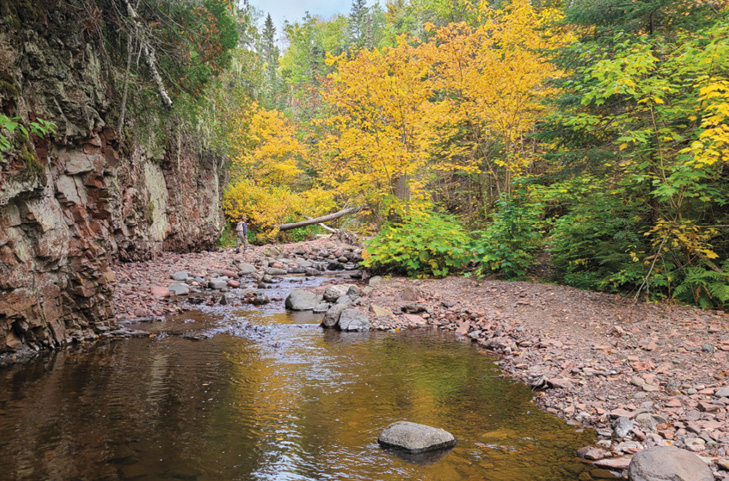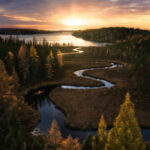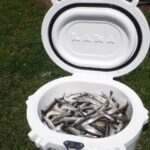Underneath the gurgling streams and rivers along the North Shore is an expansive network of little creatures that provide a glimpse into the overall health of a river’s ecosystem.
The northeast region of Minnesota is rich in diverse habitats and wildlife species. The dense boreal forest, wetlands, and riparian zones support notable species such as moose, bears, wolves, Canada lynx, and eagles, among many others. While the more prominent species tend to steal the spotlight, the smaller aquatic invertebrates, such as caddisflies and stoneflies, underneath the water’s surface, play a valuable role in the ecological health of a region.
“They are extremely sensitive to changes in habitat conditions,” David Houghton, a professor in the Biology Department at Hillsdale College in Michigan, said. Due to the high level of sensitivity, Houghton said the species is considered a biological indicator.
Caddisflies are benthic invertebrates that scour the streambed, eating leaf droppings and phytoplankton while searching for a suitable rock, log or stick to attach to by producing silk. During the metamorphosis phase, the aquatic species builds a cocoon of sorts, called a casing, out of accumulated organic matter found in the slow-moving parts of a river or lake. Similar to stoneflies and mayflies, it relies on dissolved oxygen in the water for survival.
An increase in water temperature within a lake or river can have a devastating impact on the species, as cold water contains more dissolved oxygen. In addition, water quality issues due to acidification and pollution can harm the longevity of aquatic invertebrates.
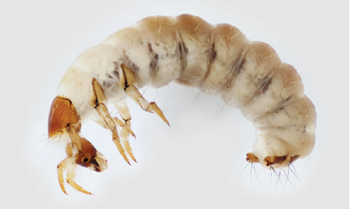
Along the North Shore tributaries, numerous species of fish, including the native coaster brook trout, rely on the caddisfly and other aquatic insects for sustenance. “If you lose that link in the food chain, you’ve essentially just stopped the food chain,” Houghton said. He explains that avid anglers or people passionate about fish should be aware of issues impacting this crucial link in the food chain. “There is no ecosystem without them.”
Houghton has spent his career studying aquatic insects across the Midwest, including the North Shore of Minnesota. During his dissertation work at the University of Minnesota in 2001, he was invited by Dr. David Etnier, a former professor at the university, to stay at his cabin on the Ontario side of Saganaga Lake at the end of the Gunflint Trail. Etnier and Houghton spent the week sampling caddisfly species on Saganaga Lake and nearby streams. Unfortunately, there wasn’t much time to rest as they spent the day catching lake trout to study stomach content and, by night, sampled insects using ultraviolet lights near streams and lakes.
The intense and fun week was a success. In total, Etnier and Houghton documented 120 different species of caddisflies in Minnesota and Ontario, of which, 32 of the species had yet to be discovered in Ontario. “It was truly an awesome experience,” Houghton said. “It was probably the single best week of my entire dissertation.”
In addition to documenting species on Saganaga Lake, Houghton has spent time sampling species on the Brule River and Cross River on the North Shore. There are approximately 185 species of caddisflies documented in Cook County. When comparing the arrowhead region of Minnesota to other areas across the nation, Houghton said it is “some of the most pristine and undisturbed habitats anywhere east of the Mississippi River.”
“The whole Boundary Waters area and the surrounding wilderness is some of the healthiest and most intact ecosystems left in eastern North America,” he added. “Just an amazing place.”
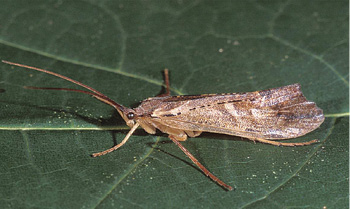
The Minnesota Pollution Control Agency states that 74 percent of the fully assessed watersheds in the arrowhead and northeast region meet water quality standards for aquatic life. While watersheds in central and southern Minnesota only meet 16 to 37 percent. Several pollutants, including phosphorus, ammonia, bacteria, nitrogen, and chloride, are the leading causes of contamination of many of Minnesota’s waterways. However, state agencies and non-profit organizations are focused on repairing and improving habitat conditions in many lakes and rivers.
The Duluth-based Gitche Gumme Chapter of Minnesota Trout Unlimited has been active in habitat improvement projects across the northern region and North Shore. In recent years they have conducted work on the Kadunce River, east of Grand Marais, including stream improvements for spawning fish and planting cedar and white pines along the riverside to prevent erosion and sediment. While the chapter has conducted a handful of habitat improvements across the northeast region in recent years, flooding during the spring of 2022 created some challenges and disruptions of projects.
While there are many uncertainties related to how climate change will impact a lake or river’s overall health, Houghton says he is more concerned about the changes associated with the hydrologic cycle. “Droughts, flooding, and groundwater changes are really difficult to predict. I think it’s going to be a problem.”
Over 20 years after his week-long dissertation experience with Etnier, Houghton shared they still keep in touch. While Etnier retired from the field in 2001, he left a lasting impression on Houghton and many in the aquatic insect ecology field. Etnier dedicated his life’s work to studying aquatic insects and helped discover over 410 species. The scientific community honored him by naming seven species after him. After his retirement, Etnier stayed involved in teaching and research. He taught classes at Chik-Wauk Museum and Nature Center on the Gunflint Trail in 2019 and 2020.
By sharing their research and passion for aquatic insects, Etnier and Houghton hope to inspire others to get outdoors and be curious about the diverse world underneath the water’s surfac


